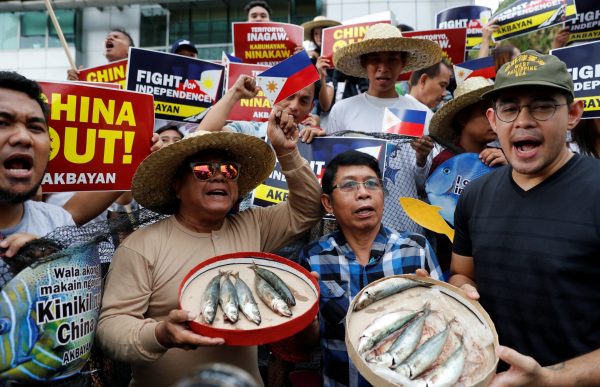Previous attempts to pursue this approach have focussed on joint development of the hydrocarbon resources in the South China Sea. But these attempts have been fraught with difficulty. Joint management of fisheries may be a better vehicle for fostering cooperation in the South China Sea because fisheries are seen as a more ‘neutral’ resource sector.
The absence of a regional governing body or a multilateral agreement to govern fisheries is one of the key contributors to the increasing levels of overfishing, illegal, unreported and unregulated (IUU) fishing and fishing-related conflicts in the South China Sea. While a network of innovative accords and conservation instruments manage fish stocks elsewhere in the world, there is no regional fisheries management organisation (RFMO) to deal with fishery issues in the South China Sea.
The establishment of an RFMO in the South China Sea is considered imperative to manage the region’s fishery issues. Cooperation through an RFMO could reduce the likelihood of states becoming involved in fishery disputes in the area. The collaborative nature of fishery agreements may also help to abate other disputes in the South China Sea, particularly territorial disputes.
But despite the potential benefits, the setting up of an RFMO will not be a panacea to the fishery problems in the South China Sea.
Given the consensus-based decision-making style that is prevalent among claimant states in the South China Sea, particularly the ‘ASEAN way’, regional treaties tend to be negotiated, implemented and revised according to the rule of consensus. Their provisions consequently tend to be vague and ambiguous.
The consensus approach can impel parties to search for the lowest common denominator in negotiations. A single nation can resist the development of a common position and demand concessions for the price of achieving consensus. As a result, the design of regional agreements can take years, sometimes even decades.
The downsides of this decision-making style are evidenced by the disappointing content of the ASEAN-initiated Declaration on the Conduct of Parties in the South China Sea and the prolonged discussions of the related Code of Conduct. The delays in the negotiation and ratification of regional agreements to protect South China Sea fisheries is especially worrisome given the rapid rate of technological change within the fishing industry.
Underwriting the plan to establish an RFMO in the South China Sea is the presumption that a regional fisheries body is an effective means of regulating IUU fishing and overfishing. But empirical evidence suggests that RFMOs experience a variety of problems, including poor data provision, failure to adopt appropriate conservation measures and inadequate compliance with management measures.
Political compromises tend to weaken RMFOs’ ability to control fishing intensity. One way an RMFO can operate is by determining total allowable catch (TAC) for fishery resources in a particular area. The implementation of a quota seeks to stabilise fish stocks to ensure that the current harvest does not trade off future productivity.
Unfortunately, the imposition of TAC limits is subject to considerable uncertainty. Biologists, ecologists and marine biologists cannot confidently determine when stocks are endangered prior to the destruction of fish stocks. The TAC limits are therefore often set according to political and economic rather than marine ecological considerations. Even in Europe scientists have come under pressure to overestimate quotas when interpreting the unpredictability of fish populations to establish a TAC system.
The effectiveness of an RFMO is also dependent on the fishery governance capacity of the region. The sheer size of the South China Sea and the magnitude of its fishing industry pose challenges to the establishment of control. According to the Fisheries Management Index that measures a state’s fisheries governance capacity, all South China Sea countries rank near the bottom for their standard of fisheries research, management and policy enforcement as well as for their stock statuses.
Another complication is the issue of Taiwan. Taiwan is not only a significant global fishing power that possesses one of the largest fishing fleets in the world, it is also a claimant party in the South China Sea. It is critical to include Taiwan in the establishment of a fisheries management body in the South China Sea to ensure that Taiwan would comply with the fishing regulations adopted by the RFMO.
But incorporating Taiwan would have its difficulties. With strained cross-Strait ties since Taiwan’s President Tsai Ing-wen took office in 2016, and given China’s longstanding unyielding stance towards Taiwan’s role in South China Sea negotiations, it is highly unlikely that China would allow Taiwan to participate in an RFMO as a full member. And it is equally doubtful that the Tsai administration would participate in an RMFO under the name ‘Chinese Taipei’.
Fishery disputes are on the rise in the South China Sea and could aggravate regional tensions if left unaddressed. But the establishment of a regional fisheries management body would be no cure-all for the region’s resource disputes or the deeper geopolitical issues at play.
Zhang Hongzhou is Research Fellow at the China Programme, Institute of Defence and Strategic Studies at the S Rajaratnam School of International Studies (RSIS), Nanyang Technological University, Singapore.
A version of this article originally appeared here on RSIS.


Zhang Hongzhou is right, of course; well-known, conflictual claims of sovereignty over some or all of the South China Sea render the project of establishing an effective regional fisheries management organization exceedingly difficult. But consider the alternative: The resounding crash, very soon, of fisheries stocks on which hundreds of millions of people depend for their livelihoods and their dinner. We can only hope that this bleak prospect will concentrate the minds and elevate the imaginations of China and the ASEAN states. Realistic quotas and effective joint enforcement modalities are essential and have been achieved elsewhere notwithstanding argument over sovereignty. And, if the will to save the SCS fisheries is there, perennial problems like the inclusion of Taiwan can be solved.